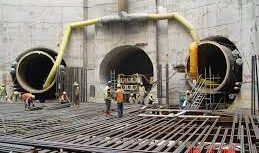In the dynamic landscape of urban infrastructure, innovative solutions are constantly sought to address the challenges posed by growing populations and urbanization. One such solution gaining prominence is the implementation of tunnel sewerage systems. This article delves into the concept of tunnel sewerage systems, highlighting their advantages, applications, and the transformative impact they can have on urban wastewater management.
Understanding Tunnel Sewerage Systems:
Tunnel sewerage systems represent a departure from traditional open-cut sewer construction methods. Instead of laying pipes through trenches or along the surface, tunnels are excavated beneath the ground to create a network for the transport of wastewater. These tunnels may vary in diameter, accommodating various sizes of sewer pipes, and can be constructed using different methods, including tunnel boring machines (TBMs) or drill and blast techniques.
Advantages of Tunnel Sewerage Systems:
- Minimized Disruption: One of the primary advantages of tunnel sewerage systems is their ability to minimize surface disruption. Unlike open-cut methods that require extensive excavation and can disrupt traffic, businesses, and communities, tunneling is conducted underground, reducing the impact on the surface environment. This is particularly beneficial in densely populated urban areas where minimizing disruption is crucial.
- Reduced Environmental Impact: Tunneling minimizes the environmental impact associated with open-cut construction. It helps preserve natural landscapes, reduces soil erosion, and avoids disturbances to ecosystems. The underground nature of the tunnel sewerage system also decreases the risk of surface water contamination during construction.
- Adaptability to Urban Constraints: Tunnel sewerage system are highly adaptable to urban constraints such as existing infrastructure, utilities, and densely developed areas. The ability to navigate beneath buildings, roads, and other structures allows for greater flexibility in system design, enabling the construction of sewer networks where traditional methods may be impractical.
- Enhanced Safety: The underground construction of the tunnel sewerage system enhances safety for both workers and the public. With the majority of construction activities taking place below ground, the risk of accidents and injuries is reduced. This is particularly relevant in urban environments where maintaining safety is a paramount concern.
- Reduced Construction Time: Tunneling often facilitates quicker construction compared to traditional open-cut methods. The use of tunnel boring machines, in particular, allows for continuous excavation, significantly reducing the time required for project completion. This accelerated construction timeline can lead to cost savings and faster deployment of essential infrastructure.
- Longer Lifespan: Tunnel sewerage systems, when constructed with durable materials and designed to withstand environmental factors, can offer a longer lifespan compared to some traditional open-cut systems. The protection provided by the surrounding soil and rock contributes to the overall durability of the infrastructure.
Applications of Tunnel Sewerage Systems:
- Urban Renewal and Redevelopment: Tunnel sewerage systems are well-suited for urban renewal projects where existing infrastructure is being upgraded or replaced. The ability to tunnel beneath established urban environments minimizes disruptions and allows for the seamless integration of upgraded sewer networks.
- High-Density Urban Areas: In densely populated urban areas with limited available space. Tunneling provides an effective solution for expanding or upgrading sewerage systems. The adaptability of tunnel construction allows for the installation of sewer pipes without extensive surface disruption.
- Environmental Protection Areas: Tunnel sewerage systems are particularly advantageous in environmentally sensitive areas where surface disturbances could have significant ecological impacts. By tunneling beneath these areas, the potential for harm to ecosystems is reduced, preserving natural habitats and water sources.
- Challenging Topographies: Urban areas with challenging topographies. Such as hilly terrain or areas prone to flooding, benefit from tunnels and sewerage systems. Tunnels can be engineered to navigate difficult landscapes, providing efficient wastewater management in regions where traditional methods may be impractical.
Challenges and Considerations:
While tunnels sewerage systems offer numerous advantages, they are not without challenges. The cost of tunnel construction can be higher than open-cut methods, and specialized equipment and expertise are required. Additionally, careful planning is essential to mitigate potential risks such as ground settlement and impacts on existing utilities.
Conclusion:
Tunnel sewerage systems represent a progressive approach to urban wastewater management, offering a host of benefits in terms of reduced disruption, environmental sustainability, adaptability, and safety. As cities worldwide grapple with the demands of growing populations and aging infrastructure. The adoption of tunnel sewerage systems presents an innovative solution to meet the evolving needs of urban environments. By delving beneath the surface, these systems contribute to the development of more resilient. Sustainable, and efficient wastewater infrastructure for the future.

